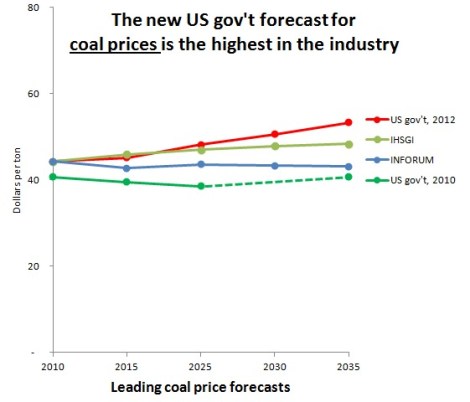U.S. energy policies prop up coal consumption in a variety of ways, some clear and some less so. For example, the Bureau of Land Management has lately come in for a drubbing for leasing public lands to coal mining companies at comically low rates, and to the detriment of taxpayers.
Official bullishness on coal extends to other government agencies too, such as the Department of Energy, which produces the nation’s energy forecasts. If you sift through the new coal projections in the Energy Information Administration’s (EIA) Annual Energy Outlook 2012, you’ll find something rather curious: The U.S. government has a more favorable outlook for coal than virtually any other major forecasting institution.
Take a look at U.S. projections for coal exports, and you’ll see that they are more aggressive than any other major forecast*:

Where most models — including even the U.S. government’s circa 2010 — see declining coal exports, the Energy Department projects growth that would reach record-setting levels and then continue to grow for more than 20 years.
There’s a similar picture for domestic U.S. coal consumption:

Although official 2012 projections showed a very substantial (16 to 19 percent) downward revision in U.S. coal use from the 2010 numbers, the official government forecast still shows domestic coal use rebounding from a 2015 low and maintaining at roughly current levels until 2035.
U.S. energy officials also project higher prices than other analysts:

The other major forecasts — including, again, the U.S. government’s 2010 model — predict roughly flat real prices for the foreseeable future. But the new 2012 forecast sees prices rising in inflation-adjusted terms by about 20 percent over the next two decades.
To be clear, I’m not saying that the official U.S. projections are wrong (and the EIA gets credit for including in the 2012 AEO the data from alternative forecasts that I’ve used here). I have no idea if any of these projections will prove to be right, and forecasting is damnably tricky work. But I do think it’s worth noting that Energy Department estimates are, at least broadly speaking, inconsistent with other respected models and forecasts.
The forecasting inconsistency is important because the official U.S. numbers have a strong influence on both private and public investment decisions. Electric utilities and port operators consult these figures, as do elected officials who set energy policy. Bullishness on coal can easily become a self-fulfilling prophecy. When official government numbers point to rising prices, sustained high consumption, and robust exports, all that can push decision-makers to do things that foster the continued use of coal.
*IHSGI (sometimes known as Global Insights) is an economic research firm. INFORUM, affiliated with the University of Maryland, produces a range of economic modeling and forecasting services. ExxonMobil and BP are, of course, big oil companies. IEA is the International Energy Agency. EVA, or Energy Ventures Analysis, is an energy consulting firm.
Thanks for Pam MacRae who provided invaluable research assistance.



